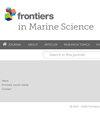Environmental conditions and carbonate chemistry variability influencing coral reef composition along the Pacific coast of Costa Rica
IF 3
2区 生物学
Q1 MARINE & FRESHWATER BIOLOGY
引用次数: 0
Abstract
Coral reef development is influenced by a wide variety of factors, including temperature, salinity, nutrient concentrations, and carbonate chemistry. Studies focusing on physicochemical drivers of coral reef distribution and composition in the Eastern Tropical Pacific (ETP) are scarce, and carbonate chemistry and nutrient data for this region are limited. This study measured coral reef composition and physicochemical parameters along the Pacific coast of Costa Rica, over a one-year period at three locations: Santa Elena and Matapalo in the north, and Parque Nacional Marino Ballena in the south. Our results show high seasonal and spatial variability of physicochemical conditions with significant differences mainly explained by inorganic nutrient concentrations, with driving processes also having a strong influence on the variability of carbonate chemistry parameters. Coastal upwelling is the main driver of the seasonal variability in Santa Elena. Comparison of seasonal dissimilarity within locations confirms the presence of a geographical gradient, with stronger influence of the upwelling in Santa Elena relative to Matapalo, where several parameters displayed a lower seasonality and a carbonate system that supports reef development throughout the year. Conversely, in Marino Ballena the river discharges during rainy season exerted a strong control on the seasonal variability. The integrated analysis of coral reef composition and physicochemical parameters suggests that in addition to inorganic nutrients carbonate chemistry also plays a key role in coral distribution. Analyzing the spatial distribution of the main reef builders provides insights into the species-specific tolerance to varying conditions.哥斯达黎加太平洋沿岸影响珊瑚礁组成的环境条件和碳酸盐化学变异性
珊瑚礁的发育受到多种因素的影响,包括温度、盐度、营养物质浓度和碳酸盐化学。关于热带东太平洋(ETP)珊瑚礁分布和组成的物理化学驱动因素的研究很少,该地区的碳酸盐化学和营养数据有限。这项研究在一年的时间里测量了哥斯达黎加太平洋沿岸三个地点的珊瑚礁组成和物理化学参数:北部的圣埃琳娜和马塔帕洛,南部的马里诺巴莱纳国家公园。研究结果表明,该区理化条件具有较高的季节变异性和空间变异性,其显著差异主要由无机养分浓度解释,驱动过程对碳酸盐化学参数的变异性也有很强的影响。沿海上升流是圣埃琳娜季节变化的主要驱动因素。不同地点之间的季节差异对比证实了地理梯度的存在,相对于Matapalo, Santa Elena的上升流的影响更大,其中一些参数显示出较低的季节性和全年支持珊瑚礁发育的碳酸盐系统。相反,在马里诺巴莱纳,雨季的河流流量对季节变化具有很强的控制作用。综合分析珊瑚礁组成和理化参数表明,除了无机营养物质外,碳酸盐化学对珊瑚分布也起着关键作用。分析主要珊瑚礁建造者的空间分布,可以深入了解物种对不同条件的特定耐受性。Pavona clavus广泛分布在北部和南部地区,表明这种巨大的珊瑚对物理化学条件的高度变化具有很强的耐受性。北部的优势珊瑚(Pavona gigantea和Pocillopora spp.)对富含营养的低文石饱和度的冷水具有高度的耐受性,而南部的主要珊瑚礁建造者之一(Porites cf. lobata .)则能更好地适应低盐度、低文石饱和度和低光强的河流排放。了解个别珊瑚物种在我们的研究地点的偏好,可以揭示影响其他地点珊瑚礁分布的环境因素。
本文章由计算机程序翻译,如有差异,请以英文原文为准。
求助全文
约1分钟内获得全文
求助全文
来源期刊

Frontiers in Marine Science
Agricultural and Biological Sciences-Aquatic Science
CiteScore
5.10
自引率
16.20%
发文量
2443
审稿时长
14 weeks
期刊介绍:
Frontiers in Marine Science publishes rigorously peer-reviewed research that advances our understanding of all aspects of the environment, biology, ecosystem functioning and human interactions with the oceans. Field Chief Editor Carlos M. Duarte at King Abdullah University of Science and Technology Thuwal is supported by an outstanding Editorial Board of international researchers. This multidisciplinary open-access journal is at the forefront of disseminating and communicating scientific knowledge and impactful discoveries to researchers, academics, policy makers and the public worldwide.
With the human population predicted to reach 9 billion people by 2050, it is clear that traditional land resources will not suffice to meet the demand for food or energy, required to support high-quality livelihoods. As a result, the oceans are emerging as a source of untapped assets, with new innovative industries, such as aquaculture, marine biotechnology, marine energy and deep-sea mining growing rapidly under a new era characterized by rapid growth of a blue, ocean-based economy. The sustainability of the blue economy is closely dependent on our knowledge about how to mitigate the impacts of the multiple pressures on the ocean ecosystem associated with the increased scale and diversification of industry operations in the ocean and global human pressures on the environment. Therefore, Frontiers in Marine Science particularly welcomes the communication of research outcomes addressing ocean-based solutions for the emerging challenges, including improved forecasting and observational capacities, understanding biodiversity and ecosystem problems, locally and globally, effective management strategies to maintain ocean health, and an improved capacity to sustainably derive resources from the oceans.
 求助内容:
求助内容: 应助结果提醒方式:
应助结果提醒方式:


